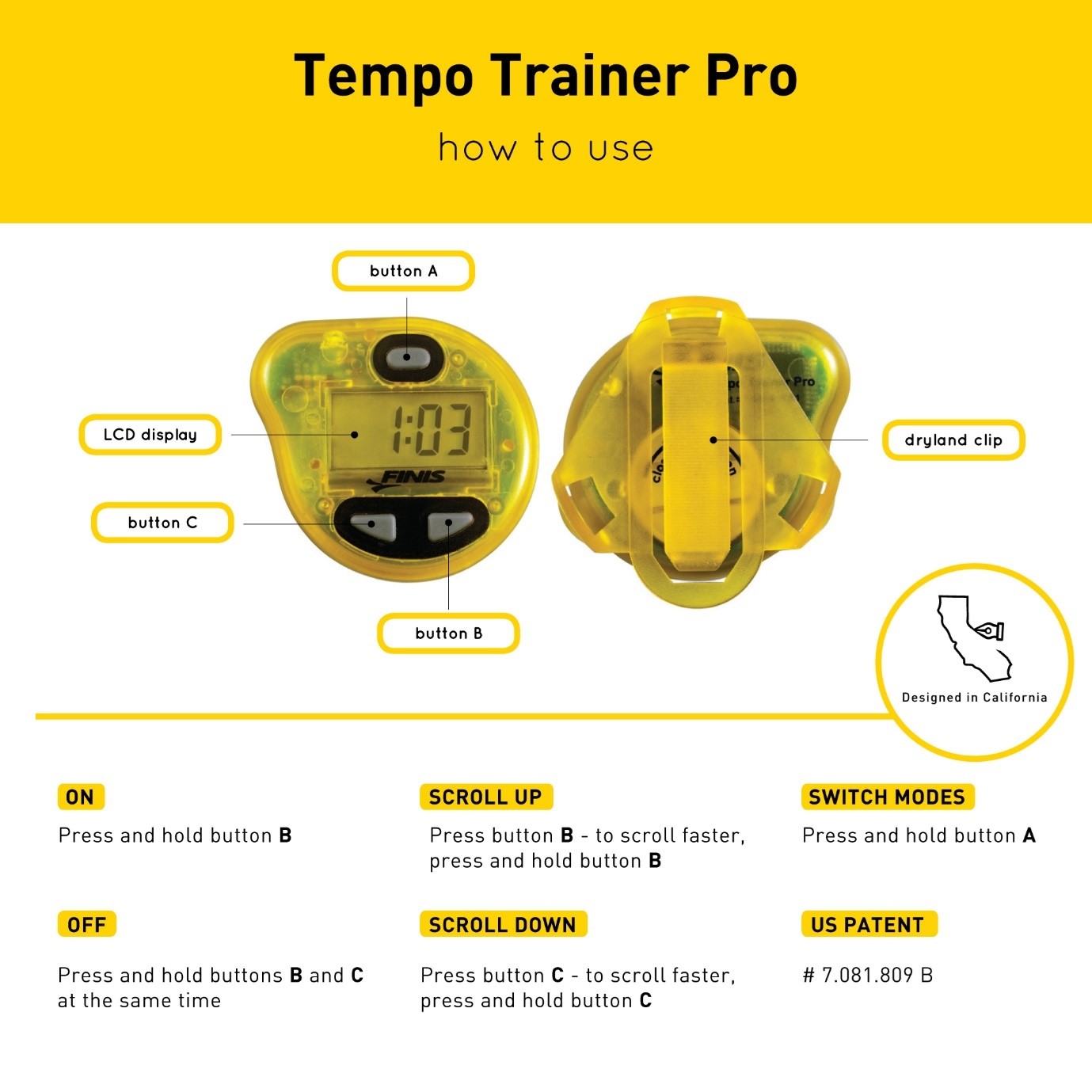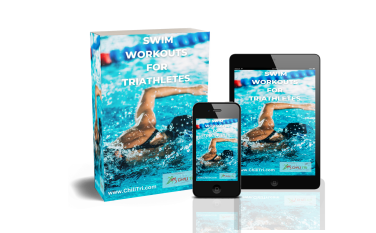Transform Your Swimming with a Finis Tempo Trainer: Swim Faster and More Efficiently
 Karen Parnell
February 07, 2023
Karen Parnell
February 07, 2023
Transform Your Swimming with a Finis Tempo Trainer: Swim Faster and More Efficiently
This article references information from Finis and their Tempo Trainer user guide and Paul Newsome, Swimsmooth. You can find out more about Swimsmooth at their website and the Finis Tempo trainer here.
Swimming is an incredibly rewarding part of a triathlon, but it can be difficult to improve technique and speed without proper guidance. In fact, many triathletes struggle with the swim leg and once they start to swim can plateau pretty quickly and find it hard to get faster. Does this sound like you?
Fortunately, the use of a Finis Tempo Trainer can help take your swimming performance to the next level!
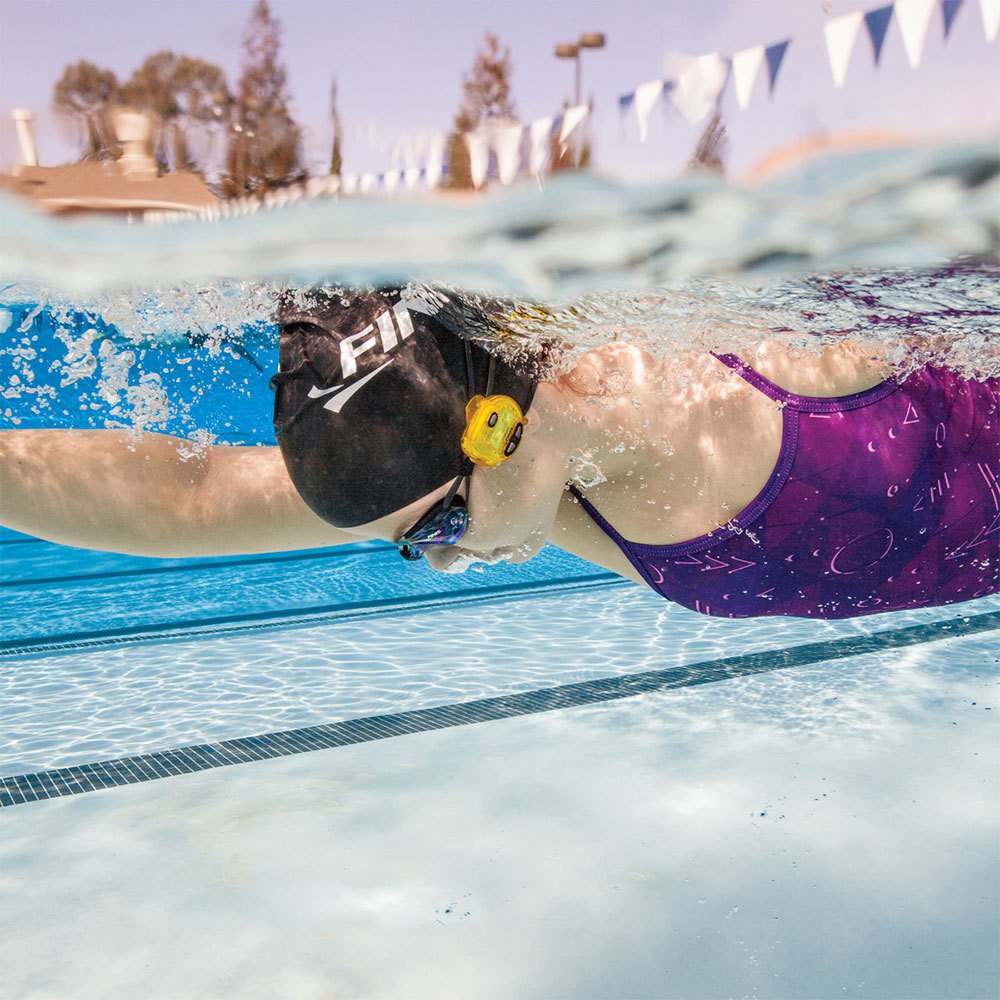
A swimmer using a Finis Tempo Trainer Pro Source: Finis
Get your FREE swimming workouts and tips book here.
What is a Tempo Trainer?
The chances are you may have one gather dust in the back of a drawer somewhere. A Finis Tempo Trainer is a small yellow device that attaches to your goggles (many people lose the clip within days so just pop it under their swim hat) and emits a beep every few seconds.
The beep is a cure for your to swim at a specific tempo or pace. The beep is adjustable so you can adjust your tempo to your desired speed. The device also has a digital display that shows your current tempo and helps you adjust the pace. The Tempo Trainer is a great way to improve your swimming technique and speed.
There are three modes you can use on your Tempo Trainer and in conjunction with your Critical Swim Speed (CSS) you can plan some great, effective swim sets. Here we will looks are the modes and how you can use them.
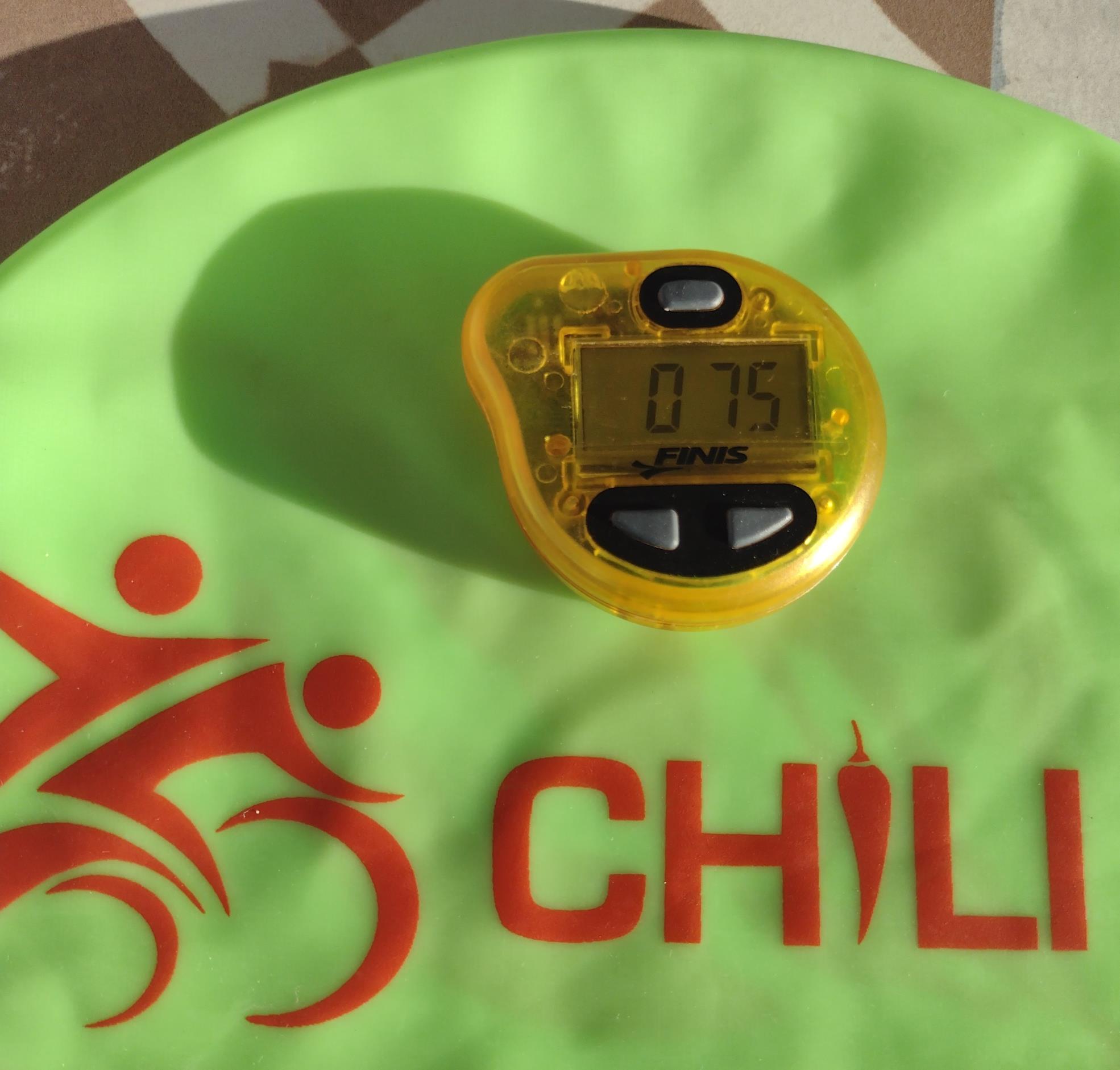
A Finis Tempo Trainer at ChiliTri
Get your FREE Open Water Swimming Sessions E-Book
Finis Tempo Trainer Specifics and Modes
The best place to start is to dive into the Tempo Trainer modes.
The Finis Tempo Trainer Pro has 3 Mode settings.
Mode 3 – “Stroke Rate” prompts you when to enter your hand into the water.
Mode 2 – lap interval – programmable to triple beep every "X" seconds to coincide with your target time per length of a 25m or 50m pool (between 1 sec and 10 minutes)
Mode 1 – similar to mode 2 but finely adjustable to 1/100th sec per 25m
Finis Tempo Trainer Simple User Guide Source: Finis
Get your FREE swimming workouts and tips book here.
Mode 1: CSS Pacing Sets - Staying with the Beeper
CSS is Critical Swim Speed and can be found by completing a time trial swim of 400m and 200m and then entering your times into a CSS calculator. You can use the ChiliTri on here:
https://chilitri.com/calculators
Click on the “swimming” tab. You can find out more about CSS and how to complete a swimming time trial here.
Once you have your CSS time go to Mode 1 on your Tempo Trainer and set you desired 25m pace. For example, if you are swimming 300-400m intervals and wish to hold 1:30 (90sec) pace per 100m. This is equivalent to 22.50s per 25m.
Similarly, 1:45 pace (105 seconds) is 25.25 seconds per 25m.
Once the tempo trainer is set, place it in your cap and give the Mode Button (single button on the top) a QUICK press so that it immediately beeps as you push off the wall. The Tempo Trainer then beeps at the interval you set. Your goal is to get to each 25m marker (middle/end of the pool) each time it beeps.
Do not try to "bank" time by getting ahead of the beeps at the start of the swim, then slow down further along the swim. Try to keep a consistent pace throughout. You should finish the interval on the wall as the tempo trainer beeps.
Typically, you will be instructed to take 1 or 2 beeps rest before setting off again.
How will Using a Tempo Trainer help your swimming?
(a) Once you are familiar with your pace and what you can hold, it will teach you your pacing over time. If you are in tune with your swimming, you should be able to intuitively know what your desired pace feels like.
(b) If you consistently train and keep to your paces, over the weeks, your aim should be to reduce the setting on the beeper by about 0.1–0.2seconds each week or two. This does not sound like much but a modest 0.1 seconds per beep translates to 0.4 seconds per 100m, or 6 seconds per 1500m race. Extrapolated over 10 weeks of 0.1 improvements, it comes to 1 min gain in an Olympic distance triathlon race.
Mode 2: Beating the Beeper – CSS Development
This operates like Mode 1, however there is less flexibility to make small fraction of second adjustments. During Beat the Beeper sets, we often prescribe intervals in Mode 2, with the Tempo Trainer set to beep every 50m, instead of every 25m and to include the rest interval such that you are required to get ahead of the beep to get your rest period. The faster swim the more rest your get!
The Tempo Trainer in Mode 2 is used very similar to a traditional pace clock in the setting of rep intervals. Only you get extra feedback every 50m, so you know how far ahead you are.
For example, a set such as 10 x 100m on 1 minute 40 seconds using the pace clock, requires a bit of mental arithmetic to figure out the send-off time with each rep.
The swimmer pushes off the wall every 1:40 with the aim of coming back faster than 1:40 to catch some rest. If you hit the wall at 1:25, you will have 15 seconds rest before the clock reaches 1 minute 40 seconds.
In Mode 2, 1 minute 40 seconds is equivalent to 100 seconds per hundred meters, hence we set the Tempo Trainer to beep every 0:50 (50 seconds per 50m). When we hit the wall at the end of the 100m, we wait for the beep, then push off again.
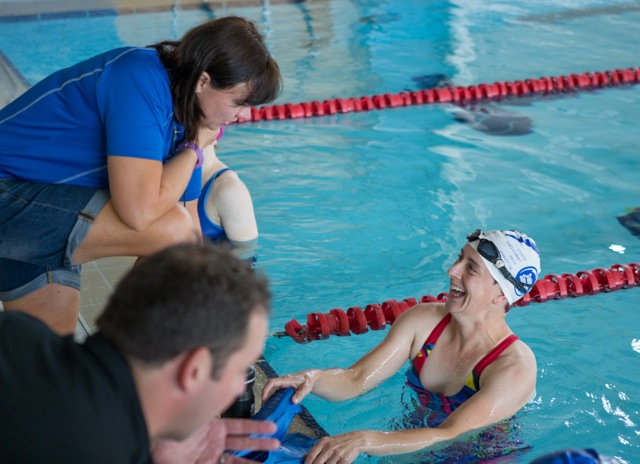
Coach Karen explaining swim technique and CSS.
Get your FREE Open Water Swimming Sessions E-Book
Mode 3: Stroke Rate Speed - a Function of Stroke Length and Stroke Rate
You can use the Tempo Trainer to train your stroke rate or arm cadence, which is measured in strokes per minute (SPM).
For example, 60 beeps per minute = 1 stroke/s, 70 beeps per minute= 1 stroke every 0.86 strokes/s. Think of it as cadence meter that beeps as your fingertips enter the water (left-right-left-right etc.).
Everyone should be aiming to be over 60 beats per minutes, with most age group triathletes falling between 65-80 strokes per minute. Elite triathletes like Alistair Brownlee have a stroke rate of around 95 SPM for Olympic distance swims of 1500m.
Swimmers are all individual and your stroke rate will depend on your arm length, stroke style and swimming experience. As a guideline though, most elites are over 80 strokes per minute, with some getting over 90 strokes per minute.
To help understand your current SPM you can complete a Ramp Test.
The Swimming Ramp Test
This is a very simple test where you can work out your current SPM so you can use it as a baseline to work from to increase your SPM. You can find out how to do it in my Blog on how to improve your swim efficiency. Once you have completed a ramp test as detailed in the Blog and have your SPM figure and find that you need to increase your stroke rate, then using a Tempo Trainer in Mode 3 and increasing it gradually over time will help you do this.
Remember to do a Ramp Test regularly (about every 6 weeks) to make sure you are making progress with both your Stroke Rate, Stroke Length and Speed.
Here’s a FREE Swim Workouts for Triathletes Book with swim workouts, tips, technique, drills, kit and terms.
Swim Workouts for Triathletes FREE Book
Practical Ways to use your Tempo Trainer and what you may see in a Training Plan
Below are five ways to use your Tempo Trainer to make you a better swimmer and what it might look like in a training session
plan.
Practical Example of how to use your Tempo Trainer in Mode 3
Mode 3 is used for stroke rate development and shows on the screen stroke per minute e.g., 60 = 60 strokes per minute.
This mode will help you work on the rhythm and timing of your stroke. When in this mode you can use your ramp test to determine your natural current stroke rate, say this is 60, and you want to increase your stroke rate. By using the up arrow increase the number to 61 = 61 SPM. Then swim with it under your hat and time your hand entry to enter the water every beep. I like to try to time it to when my fingertips hit the surface of the water.
You may see this in your training session plan as:
Base stroke rate = 60 and in the plan, it wants you to swim the 100m interval at base rate plus 2 with a rest interval (RI) of 10 seconds
100 freestyle with Tempo Trainer Pro RI10s
Base stroke rate +2
62 SPM (M3)
.jpg)
A chart to Compare your Pace for 100m versus your Stroke Rate Source: Swim Smooth
Practical Example of how to use your Tempo Trainer in Mode 2
Note: Red Mist and RM refer to swim sessions from Swimsmooth. You can find Swimsmooth plans here.
This mode is for lap intervals and Red Mist or RM cycles. For this mode you will need to do a time trial and work out your time for 100m. E.g., 2 minutes 23 seconds for 100m.
You will need to divide this 2 min 23 sec by 4 to get your 25m time
E.g., 2 minutes 23 seconds equals 144 seconds. Divide 144 seconds by 4 and you get 36 seconds which is your 15m time.
Select Mode 2 by pressing and holding the top button and select 2. Then set it to 0:36 using the left and right buttons, left to decrease the number and right to increase the number.
Pop the tempo trainer under your hat and set off swimming on the beep and try to reach the 25m point on the next beep and so on. If you can do this on the beep, then you know you are swimming 2 minutes 23 seconds per 100m.
To swim slower bring this number up or faster take it up in 1 second increments in Mode 2.
E.g., if a swimmer wants to swim faster, say 2 minutes 20 secs per 100m you can set it to 0:35. But this is 4 seconds per 100m which may be too much in one go!
Red Mist or RM cycles are common on training session plans, and it may look like this:
4 x 50 Freestyle
RM Cycle 4 1:04 / 50m (M2 - beat the beep)
In this example let’s assume your 100m time is 2 minutes which is your CSS or threshold pace. Divide this by 2 which is 1 minute per 50m.
In this example you will swim your 200’s in RM cycle 4 which means add 4 seconds to every 50m. Set your Tempo Trainer mode 2 and enter 1:04 on the screen. Start the beeper and swim the desired distance which is 50m in this example and you will be ahead of the beeper. So use this time as rest and set off on your next 50m on the next beep.
How to use a Finis Tempo Trainer Pro in 30 Seconds! Source: Swim Smooth
Get your FREE Open Water Swimming Sessions E-Book
Practical Example of how to use your Tempo Trainer in Mode 1
This mode is used for CCS or Threshold development and is also for stroke rate improvement. This mode is precise to 1/100th of a second. Using the example in Mode 3 were 1 second per 25m takes off 4 seconds off your 100m which may feel like a big jump you can use Mode 1 to set it to half a second off which is 2 seconds off your 100m.
To set this select Mode 1 and set the screen to 35:50 to take half a second off each 100m you swim. Swim with the beep per 25m your swim
In a training plan you may also see Mode 1 used like this for CSS development:
3 x 100 freestyle @CSS -2s/100
02:34.0 (CSS -2 /100m)
38.50 / 25m (M1 - stay with beep)
In this example the swimmer has a CSS pace of 2 minute 36 second per 100m. The 100m intervals needs to be swam at CSS-2/100m so take off 2 from your CSS pace to be 02:24.0 and set the Tempo Trainer to 38.50 (2:24 is 154 seconds divide this by 4 to give 38.50) and try to swim each 100m staying with the beep. This will feel harder than normal and develop your endurance over time by forcing you to swim above your CSS pace per 100m.
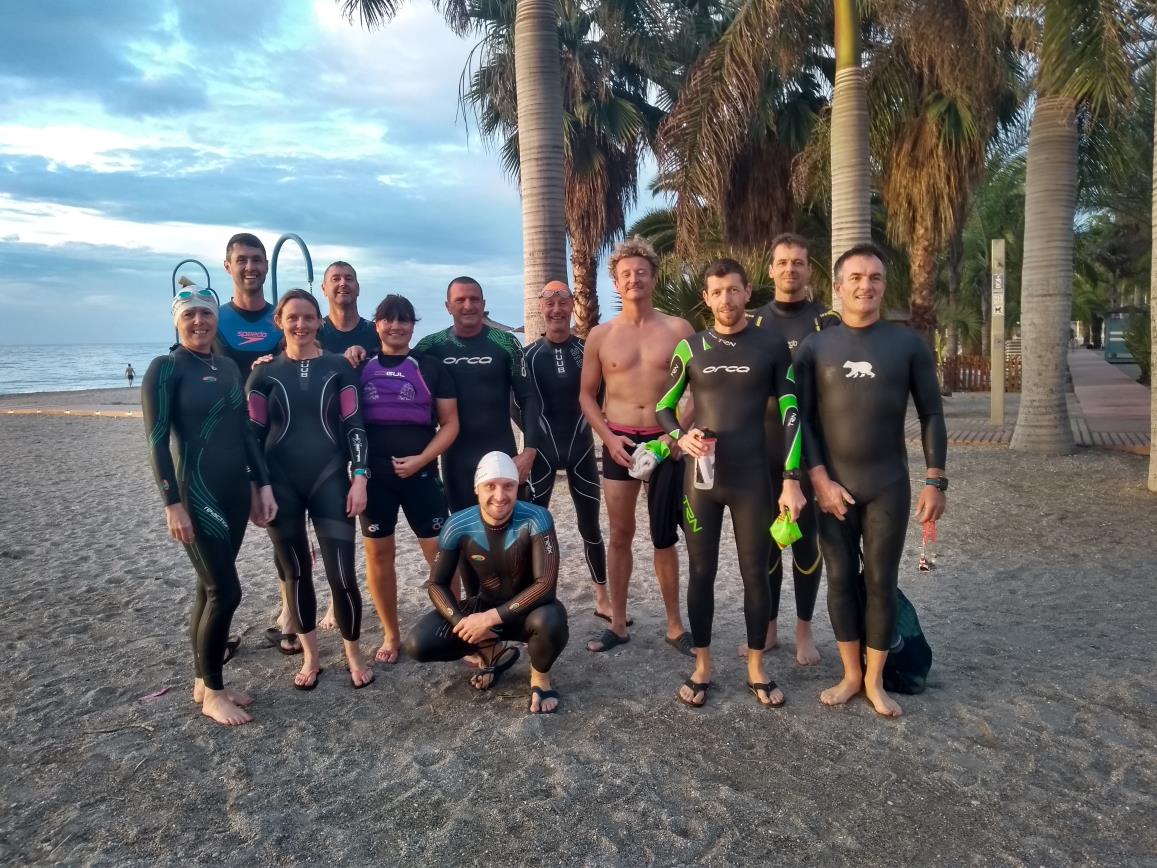
Open Water Swimming at a ChiliTri Swimming Clinic with their Tempo Trainer Pros
Get your FREE Open Water Swimming Sessions E-Book
Other Ways to use your Tempo Trainer
The Tempo Trainer is not just for the swimming pool but can be used to improve your sea swimming, cycling, and running cadence!
In the sea you can set the Tempo Trainer to a specific SPM so you can keep to your desired stroke rate even over those long swims when you drift off.
When you cycle you may have tried riding at different cadences. You may have noticed that it’s easy to let your cadence slip especially longer into a ride or when climbing hills. You can use the Finis Tempo Trainer Pro to practice holding the correct cadence on the turbo trainer or as you ride a particular hill, especially if it’s the one where you’ve been looking to move up the Strava league table or hit a PR or even challenge for the KOM!
Similarly, when running you can use the tempo trainer to practice running at a particular cadence. This is useful in technique or track sessions where you can see what difference a higher cadence makes to your run speed and efficiency. 180-foot strikes per minute is held to be the ‘gold standard’ for runners and whilst one-size doesn’t always fit all, there are benefits to be had from running with a fast cadence and being able to increase your ‘turn-over’.
Matching you run cadence to your bike cadence in a triathlon may have benefits and help with the “wobbly legs” in Transition 2 (T2).
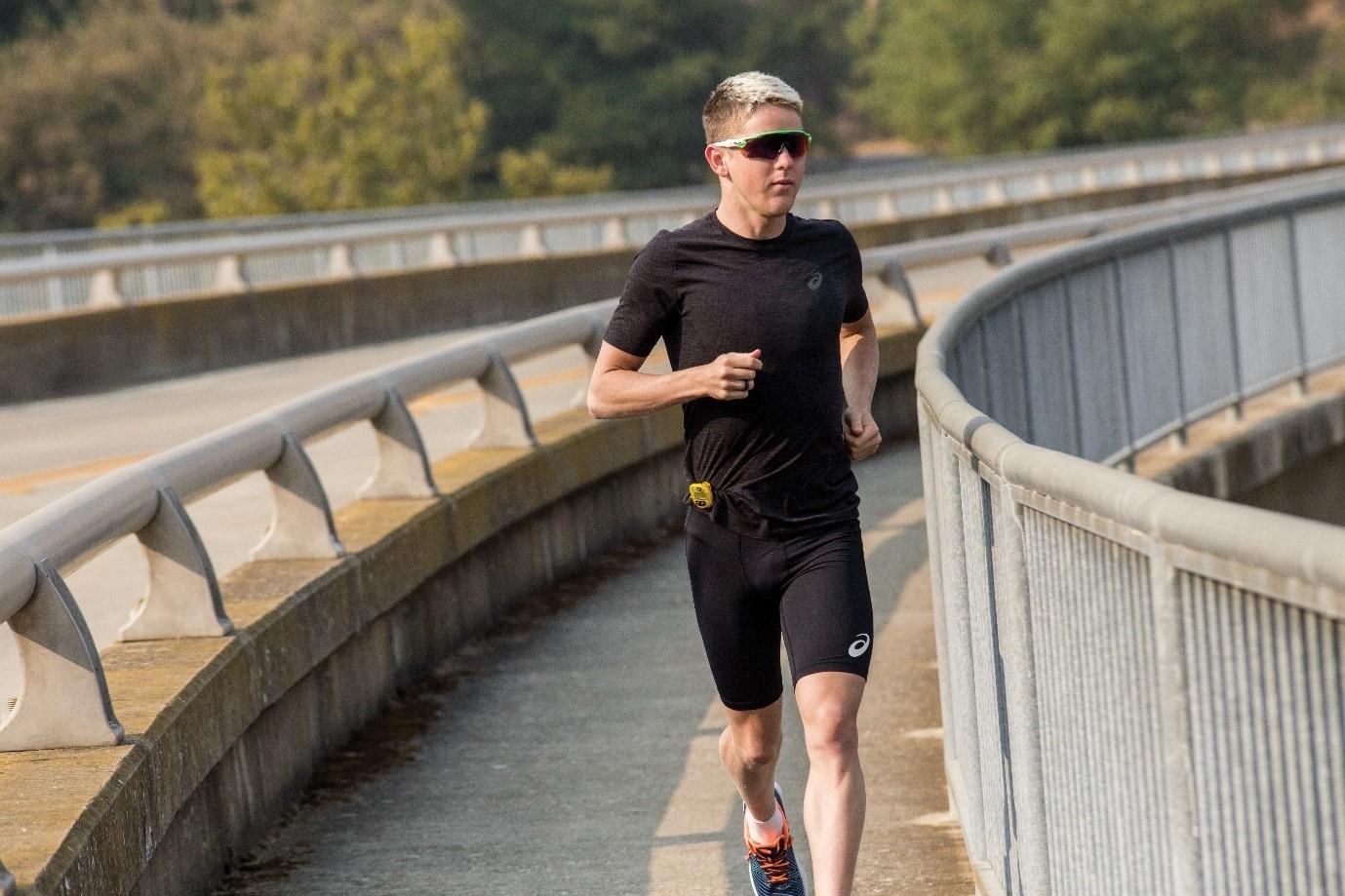
Henri Schoeman Running with a Tempo Trainer Source: Finis
“The Tempo Trainer Pro is really effective in setting up my ideal stroke rate in the water. What makes it even better, is that I also get to use it while running to set up the perfect”. Henri Schoeman 2016 Olympic Bronze Medallist.
Get your FREE Guide to Running Speed and Technique
Conclusion: Tempo Trainer to make you a Faster Swimmer
The Finis Tempo Trainer is an invaluable tool for you as a swimmer and triathlete looking to improve your technique and increase your speed. It attaches to your goggles (or under your swim hat) and emits a beep every few seconds, providing a cue for you to swim at a specific speed or tempo. By focussing on the beep and swimming to the rhythm it creates you can ensure that your strokes are smooth and powerful and build your endurance and speed over time. In Mode 1 you can focus on improving your swim pacing, Mode 2 can help you improve your Critical Swim Speed (CSS) or Threshold and Mode 3 can be used to up your arm cadence or Strokes Per Minute (SPM) which will all make you a faster and more efficient swimmer.
Get your FREE swimming workouts and tips book here.
Karen Parnell is a Level 3 British Triathlon and IRONMAN Certified Coach, 8020 Endurance Certified Coach, WOWSA Level 3 open water swimming coach and NASM Personal Trainer and Sports Technology Writer.
Karen is currently studying for an MSc in Sports Performance Coaching at the University of Stirling.
Need a training plan? I have plans on TrainingPeaks and FinalSurge:
I also coach a very small number of athletes one to one for all triathlon and multi-sport distances, open water swimming events and running races, email me for details and availability. Karen.parnell@chilitri.com
Get your FREE Guide to Running Speed and Technique
Get your FREE Swim Workouts for Triathletes E-book
Get your FREE Open Water Swimming Sessions E-Book
FAQ Finis Tempo Trainer
What is a Finis Tempo Trainer Pro?
The Tempo Trainer Pro is an electronic training device that transmits an audible beep to help you develop a consistent pace and tempo. The device is also floatable so that it is not easily lost in a pool, lake, or ocean.
How can a Finis Tempo Trainer help improve my swimming technique?
It can be used to progressively increase your strokes per minute, critical swim speed and pace over time by swimming to the beep or beating the beep.
What is Critical Swim Speed (CSS)?
Critical Swim Speed (CSS) is defined as the theoretical fastest pace that a swimmer can maintain continuously without exhaustion, your aerobic swimming threshold. Your CSS is computed using your time for a 400 m or yard time trial, and your time for a 200 m or yard time trial.
How do I calculate my CSS?
Complete a 400m swimming time trial and then enter the results in the ChiliTri CSS calculator here.
Is the Tempo Trainer waterproof?
Yes, it the Finis Tempo Trainer is waterproof and can be use in the pool, lakes and sea.
What is Strokes per Minute (SPM)?
Stroke rate is the number of strokes you take per minute, or SPM (Strokes Per Minute).
What is a swimming Ramp Test?
The Ramp Test looks at your speed and stroke rate efficiency over a range of stroke rates, as controlled by the Tempo Trainer Pro.
References
TTP_ReferenceGuide_Spreads.pdf (finisswim.com)
#traithlontrainingplans #runningtrainingplans #swimmingtrainingplans
This website uses affiliate links which may earn a commission at no additional cost to you. As an Amazon Associate I earn from qualifying purchases. which may cover part of a cup of coffee for me to fuel my training.
